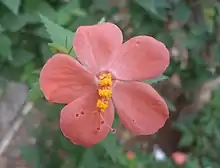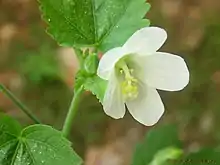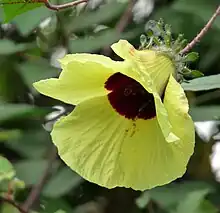Hibiscus
Hibiscus[2][3] is a genus of flowering plants in the mallow family, Malvaceae. The genus is quite large, comprising several hundred species that are native to warm temperate, subtropical and tropical regions throughout the world. Member species are renowned for their large, showy flowers and those species are commonly known simply as "hibiscus", or less widely known as rose mallow. Other names include hardy hibiscus, rose of sharon, and tropical hibiscus.
| Hibiscus | |
|---|---|
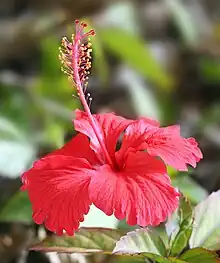 | |
| Hibiscus rosa-sinensis | |
| Scientific classification | |
| Kingdom: | Plantae |
| Clade: | Tracheophytes |
| Clade: | Angiosperms |
| Clade: | Eudicots |
| Clade: | Rosids |
| Order: | Malvales |
| Family: | Malvaceae |
| Subfamily: | Malvoideae |
| Tribe: | Hibisceae |
| Genus: | Hibiscus L. |
| Type species | |
| Hibiscus syriacus L. | |
| Species | |
| Synonyms[1] | |
| |
The genus includes both annual and perennial herbaceous plants, as well as woody shrubs and small trees. The generic name is derived from the Greek name ἰβίσκος (ibískos) which Pedanius Dioscorides gave to Althaea officinalis (c. 40–90 AD).[4][5]
Several species are widely cultivated as ornamental plants, notably Hibiscus syriacus and Hibiscus rosa-sinensis.[6]
A tea made from hibiscus flowers is known by many names around the world and is served both hot and cold. The beverage is known for its red colour, tart flavour, and vitamin C content.
Description
The leaves are alternate, ovate to lanceolate, often with a toothed or lobed margin (dentate). The flowers are large, conspicuous, trumpet-shaped, with five or more petals, colour from white to pink, red, blue, orange, peach,[7] yellow or purple,[8] and from 4–18 cm broad.
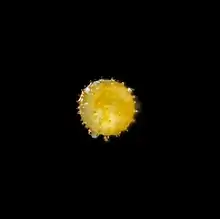

Flower colour in certain species, such as H. mutabilis and H. tiliaceus, changes with age.[9] The fruit is a dry five-lobed capsule, containing several seeds in each lobe, which are released when the capsule dehisces (splits open) at maturity. It is of red and white colours. It is an example of complete flowers.

Species
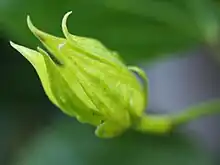
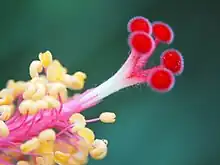
.jpg.webp)
In temperate zones, probably the most commonly grown ornamental species is Hibiscus syriacus, the common garden hibiscus, also known in some areas as the "rose of Althea" or "rose of Sharon" (but not to be confused with the unrelated Hypericum calycinum, also called "rose of Sharon"[10]). In tropical and subtropical areas, the Chinese hibiscus (H. rosa-sinensis), with its many showy hybrids, is the most popular hibiscus.
Several hundred species are known, including:
- Hibiscus acapulcensis Fryxell[11]
- Hibiscus acetosella Welw. ex Hiern.[12] – false roselle
- Hibiscus aculeatus Walter — comfortroot
- Hibiscus aethiopicus L.
- Hibiscus aponeurus Sprague & Hutch.[13]
- Hibiscus arnottianus A.Gray — kokiʻo ʻula (Hawaii)
- Hibiscus bifurcatus Cav. — fork-bracted rosemallow
- Hibiscus biseptus S.Watson — Arizona rosemallow
- Hibiscus boryanus DC. — foulsapate marron (Mauritius and Réunion)
- Hibiscus brackenridgei A.Gray — Hawaiian hibiscus maʻo hau hele
- Hibiscus caesius Garcke — dark-eyed hibiscus (southwestern Tanzania to South Africa)
- Hibiscus calyphyllus — lemonyellow rosemallow (tropical Africa)
- Hibiscus cameronii — Cameron's hibiscus, pink hibiscus
- Hibiscus cannabinus L. — Kenaf
- Hibiscus clayi O.Deg. & I.Deg.— Hawaiian red hibiscus (Hawaii)
- Hibiscus clypeatus — Congo mahoe
- Hibiscus coccineus (Medik.) Walter — scarlet rosemallow
- Hibiscus columnaris — mahot rempart
- Hibiscus coulteri — desert rosemallow
- Hibiscus dasycalyx — Neches River rosemallow
- Hibiscus denudatus Benth.—pale face (Southwestern US, Northwestern Mexico)
- Hibiscus dioscorides A.G.Mill. (Yemen)
- Hibiscus diriffan A.G.Mill. (Yemen)
- Hibiscus diversifolius— swamp hibiscus
- Hibiscus elatus – mahoe
- Hibiscus engleri – wild hibiscus
- Hibiscus erlangeri (Gürke) Thulin (Ethiopia and Somalia)
- Hibiscus escobariae
- Hibiscus fragilis DC.—mandrinette (Mascarene Islands)
- Hibiscus furcellatus Desr.—lindenleaf rosemallow (Caribbean, Florida, Central America, South America, Hawaii)
- Hibiscus genevii Bojer (Mauritius)
- Hibiscus grandiflorus Michx. — swamp rosemallow (Southeastern US)
- Hibiscus grewiifolius
- Hibiscus hamabo
- Hibiscus hastatus
- Hibiscus heterophyllus — native rosella
- Hibiscus hirtus — lesser mallow
- Hibiscus hispidissimus
- Hibiscus hybridus
- Hibiscus insularis Endl. — Phillip Island hibiscus (Phillip Island)
- Hibiscus kokio—red rosemallow
- Hibiscus laevis All. (=H. militaris) — halberd-leaved rosemallow (central and eastern North America)
- Hibiscus lasiocarpos — woolly rosemallow
- Hibiscus leptocladus (Northwest Australia)
- Hibiscus lilacinus — lilac hibiscus
- Hibiscus liliiflorus — Rodrigues tree hibiscus
- Hibiscus lunariifolius
- Hibiscus macilwraithensis (Australia)
- Hibiscus macrophyllus — largeleaf rosemallow
- Hibiscus macropodus
- Hibiscus makinoi — Okinawan hibiscus
- Hibiscus malacophyllus Balf.f. (Yemen)
- Hibiscus martianus— heartleaf rosemallow
- Hibiscus mesnyi Pierre ex Laness. (Vietnam endemic)
- Hibiscus moscheutos L. — crimsoneyed rosemallow (Central and Eastern North America)
- Hibiscus mutabilis L. — cotton rosemallow, Confederate rose (East Asia)
- Hibiscus paramutabilis
- Hibiscus phoeniceus — Brazilian rosemallow
- Hibiscus platanifolius
- Hibiscus pusillus Thunb. - bladderweed
- Hibiscus quattenensis
- Hibiscus poeppigii — Poeppig's rosemallow
- Hibiscus radiatus — monarch rosemallow
- Hibiscus rosa-sinensis L. — Chinese hibiscus (East Asia)
- Hibiscus sabdariffa L. — roselle, omutete, or sorrel
- Hibiscus schizopetalus — fringed rosemallow
- Hibiscus scottii
- Hibiscus socotranus
- Hibiscus sinosyriacus
- Hibiscus splendens
- Hibiscus stenanthus Balf.f. (Yemen)
- Hibiscus striatus — striped rosemallow
- Hibiscus sturtii (Australia)
- Hibiscus syriacus L. (type species) — rose of Sharon (Asia)
- Hibiscus taiwanensis S.Y. Hu
- Hibiscus tiliaceus L. — sea hibiscus (Australia, Southeast Asia, Oceania)
- Hibiscus tozerensis (Australia)
- Hibiscus trilobus—threelobe rosemallow
- Hibiscus trionum L. — flower-of-an-hour
- Hibiscus vitifolius — tropical rose mallow
- Hibiscus waimeae A.Heller — kokiʻo keʻokeʻo (Hawaii)
Formerly placed in the genus
- Abelmoschus esculentus (L.) Moench (as H. esculentus L.)
- Abelmoschus ficulneus (L.) Wight & Arn. (as H. ficulneus L.)
- Abelmoschus manihot subsp. manihot (as H. manihot L.)
- Abelmoschus manihot var. pungens (Roxb.) Hochr. (as H. pungens Roxb.)
- Abelmoschus manihot var. tetraphyllus (Roxb. ex Hornem.) Borss. Waalk. (as H. tetraphyllus Roxb. ex Hornem.)
- Abelmoschus moschatus subsp. moschatus (as H. abelmoschus L.)
- Abelmoschus moschatus subsp. tuberosus (Span.) Borss. Waalk. (as H. sagittifolius Kurz)
- Alyogyne cuneiformis (DC.) Lewton (as H. cuneiformis DC.)
- Alyogyne hakeifolia (Giord.) Alef. (as H. hakeifolius Giord.)
- Alyogyne huegelii (Endl.) Fryxell (as H. wrayae Lindl.)
- Alyogyne pinoniana (Gaudich.) Fryxell (as H. pinonianus Gaudich.)
- Firmiana simplex (L.) W.Wight (as H. simplex L.)
- Lagunaria patersonia subsp. patersonia (as H. patersonius Andrews)
- Kosteletzkya adoensis (Hochst. ex A. Rich.) Mast. (as H. adoensis Hochst. ex A.Rich.)
- Kosteletzkya pentacarpos (L.) Ledeb. (as H. pentacarpos L.)
- Kosteletzkya tubiflora (DC.) Blanch. & McVaugh (as H. tubiflorus DC.)
- Kosteletzkya virginica (L.) C.Presl ex A.Gray (as H. virginicus L.)
- Pavonia arabica Hochst. & Steud. ex Boiss. (as H. flavus Forssk.)
- Pavonia spinifex (L.) Cav. (as H. spinifex L.)
- Radyera farragei (F.Muell.) Fryxell & S.H.Hashmi (as H. farragei F.Muell.)
- Thespesia lampas (Cav.) Dalzell (as H. lampas Cav.)
- Thespesia populnea (L.) Sol. ex Corrêa (as H. populneoides Roxb. or H. populneus L.)[14]
Uses
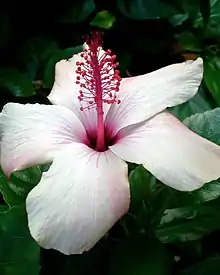
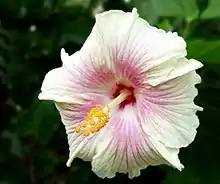
Landscaping
Many species are grown for their showy flowers or used as landscape shrubs, and are used to attract butterflies, bees, and hummingbirds.[15]
Hibiscus is a very hardy, versatile plant and in tropical conditions it can enhance the beauty of any garden. Being versatile it adapts itself easily to balcony gardens in crammed urban spaces and can be easily grown in pots as a creeper or even in hanging pots. It is a perennial and flowers throughout the year. As it comes in a variety of colors, it's a plant which can add vibrancy to any garden.
The only infestation that gardeners need to be vigilant about is mealybugs. Mealybug infestations are easy to spot as they are clearly visible as a distinct white cottony infestation on buds, leaves or even stems. To protect the plant you need to trim away the infected part, spray with water, and apply an appropriate pesticide.
Paper
One species of Hibiscus, known as kenaf (Hibiscus cannabinus), is extensively used in paper-making.
Rope and construction
The inner bark of the sea hibiscus (Hibiscus tiliaceus), also called 'hau', is used in Polynesia for making rope, and the wood for making canoe floats. The ropes on the missionary ship Messenger of Peace were made of fibres from hibiscus trees.[16]
Beverage
The tea made of the calyces of Hibiscus sabdariffa is known by many names in many countries around the world and is served both hot and cold. The beverage is well known for its red colour, tartness and unique flavour. Additionally, it is highly nutritious because of its vitamin C content.
It is known as bissap in West Africa, "Gul e Khatmi" in Urdu & Persian, agua de jamaica in Mexico and Central America (the flower being flor de jamaica) and Orhul in India. Some refer to it as roselle, a common name for the hibiscus flower. In Jamaica, Trinidad and many other islands in the Caribbean, the drink is known as sorrel (Hibiscus sabdariffa; not to be confused with Rumex acetosa, a species sharing the common name sorrel). In Ghana, the drink is known as soobolo in one of the local languages.
In Cambodia, a cold beverage can be prepared by first steeping the petals in hot water until the colors are leached from the petals, then adding lime juice (which turns the beverage from dark brown/red to a bright red), sweeteners (sugar/honey) and finally cold water/ice cubes.
In Egypt and Sudan, hibiscus tea is known as karkadé (كركديه), and is served as both a hot and a cold drink.
Hibiscus (also known in Sri Lanka as shoe flower, සපත්තු මල, වද මල in Sinhalese) is an ingredient with a rich heritage of refreshing Lankans. Fresh juices, ice teas and syrups made of the Hibiscus flower are famous refreshments among Sri Lankans.
Food
Dried hibiscus is edible, and it is often a delicacy in Mexico. It can also be candied and used as a garnish, usually for desserts.[17]
The roselle (Hibiscus sabdariffa) is used as a vegetable. The species Hibiscus suratensis Linn synonymous with Hibiscus aculeatus G. Don is noted in Visayas in the Philippines as being a souring ingredient for almost all local vegetables and menus. Known as labog in the Visayan area (or labuag/sapinit in Tagalog), the species is an ingredient in cooking native chicken soup.
Hibiscus species are used as food plants by the larvae of some lepidopteran species, including Chionodes hibiscella, Hypercompe hambletoni, the nutmeg moth, and the turnip moth.
Folk medicine
Hibiscus rosa-sinensis is described as having a number of medical uses in Indian Ayurveda.[18]
Claimed effects on blood pressure
It has been claimed that sour teas derived from Hibiscus sabdariffa may lower blood pressure.[19][20]
Pregnancy and lactation
While the mechanism is not well understood, previous animal studies have demonstrated both an inhibitory effect of H. sabdariffa on muscle tone and the anti-fertility effects of Hibiscus rosa-sinensis, respectively.[8][21] The extract of H. sabdariffa has been shown to stimulate contraction of the rat bladder and uterus;[8] the H. rosa-sinensis extract has exhibited contraceptive effects in the form of estrogen activity in rats.[21] These findings have not been observed in humans. The Hibiscus rosa-sinensis is also thought to have emmenagogue effects which can stimulate menstruation and, in some women, cause an abortion.[22][23][24] Due to the documented adverse effects in animal studies and the reported pharmacological properties, the H. sabdariffa and H. rosa-sinensis are not recommended for use during pregnancy.[24]
Drug interactions
It is postulated that H. sabdariffa interacts with diclofenac, chloroquine and acetaminophen by altering the pharmacokinetics. In healthy human volunteers, the H. sabdariffa extract was found to reduce the excretion of diclofenac upon co-administration.[25] Additionally, co-administration of Karkade (H. sabdariffa), a common Sudanese beverage, was found to reduce chloroquine bioavailability.[26] However, no statistically significant changes were observed in the pharmacokinetics of acetaminophen when administered with the Zobo (H. sabdariffa) drink.[27] Further studies are needed to demonstrate clinical significance.
Symbolism and culture
The red hibiscus is the flower of the Hindu goddess Kali, and appears frequently in depictions of her in the art of Bengal, India, often with the goddess and the flower merging in form. The hibiscus is used as an offering to Kali and the god Ganesha in Hindu worship.[28][29]
In the Philippines, the gumamela (the local name for hibiscus) is used by children as part of a bubble-making pastime. The flowers and leaves are crushed until the sticky juices come out. Hollow papaya stalks are then dipped into this and used as straws for blowing bubbles. Together with soap, hibiscus juices produce more bubbles. It is also called "Tarukanga" in Waray, particularly in Eastern Samar province.
The hibiscus flower is traditionally worn by Pacific island women, and is a known shared custom that if the flower is worn behind the left ear, the woman is married or has a boyfriend. If the flower is worn on the right, she is single or openly available for a relationship. The pink hibiscus flower has its origins in Asia and the Pacific Islands, where it has served as a symbol of beauty, femininity, and young love. It is commonly associated with the Hawaiian culture and the Aloha spirit, which celebrates love, happiness, and peace. [30]
A stylized image of the hibiscus flower was used as a logo of Air_Polynésie.
Nigerian author Chimamanda Ngozi Adichie named her first novel Purple Hibiscus after the delicate flower.
The bark of the hibiscus contains strong bast fibres that can be obtained by letting the stripped bark set in the sea to let the organic material rot away.
As a national and state symbol
The hibiscus is a national symbol of Haiti,[31] and the national flower of nations including the Solomon Islands and Niue.[32] Hibiscus syriacus is the national flower of South Korea,[33] and Hibiscus rosa-sinensis is the national flower of Malaysia.[32] Hibiscus brackenridgei is the state flower of Hawaii.[34]
References
- Hibiscus L. Plants of the World Online. Retrieved 19 June 2023.
- Oxford English Dictionary
- Sunset Western Garden Book, 1995:606–607
- Lawton, Barbara Perry (2004). Hibiscus: Hardy and Tropical Plants for the Garden. Timber Press. p. 36. ISBN 978-0-88192-6545.
- Henry George Liddell, Robert Scott, A Greek-English Lexicon, ἰβίσκος
- Brickell, Christopher, ed. (2008). The Royal Horticultural Society A-Z Encyclopedia of Garden Plants. United Kingdom: Dorling Kindersley. p. 534. ISBN 9781405332965.
- "Hibiscus (National Gardening Association)". Retrieved 26 October 2016.
- Fouda, A.M.; Daba, M.Y.; Dahab, G.M. (2007). "Inhibitory effects of aqueous extracts of Hibiscus sabdariffa on contractility of the rat bladder and uterus". Can J Physiol Pharmacol. 85 (10): 1020–31. doi:10.1139/y07-093. PMID 18066103.
- Lee, David Webster (2007). Nature's Palette: the Science of Plant Color. University of Chicago Press. p. 183. ISBN 978-0-226-47052-8.
- BSBI List 2007 (xls). Botanical Society of Britain and Ireland. Archived from the original (xls) on 2015-06-26. Retrieved 2014-10-17.
- "Hibiscus acapulcensis Fryxell — The Plant List". Retrieved 26 October 2016.
- "Hibiscus acetosella Welw. ex Hiern — The Plant List". Retrieved 26 October 2016.
- Bussmann, R. W.; Gilbreath, G. G.; Solio, J.; Lutura, M.; Lutuluo, R.; Kunguru, K.; Wood, N.; Mathenge, S. G. (2006). "Plant use of the Maasai of Sekenani Valley, Maasai Mara, Kenya". Journal of Ethnobiology and Ethnomedicine. 2: 22. doi:10.1186/1746-4269-2-22. PMC 1475560. PMID 16674830.
- "GRIN Species Records of Hibiscus". Germplasm Resources Information Network. United States Department of Agriculture. Archived from the original on 2014-09-16. Retrieved 2011-02-10.
- "Floridata Master Plant List". Retrieved 26 October 2016.
- "Missionary Ships". Shipping Wonders of the World (Part 51). 26 January 1937. Retrieved 24 March 2019.
- http://nrn.com/penton_404_redirect. Retrieved 26 October 2016.
{{cite web}}: Missing or empty|title=(help) - Plants for a Future: Hibiscus rosa-sinensis. (accessed 07/05/2009)
- Haji Faraji, M.; Haji Tarkhani, A.H (1999). "The effect of sour tea (Hibiscus sabdariffa) on essential hypertension". Journal of Ethnopharmacology. 65 (3): 231–236. doi:10.1016/S0378-8741(98)00157-3. PMID 10404421.
- Da-Costa-Rocha, Inês; Bonnlaender, Bernd; Sievers, Hartwig; Pischel, Ivo; Heinrich, Michael (2014). "Hibiscus sabdariffa L. – A phytochemical and pharmacological review". Food Chemistry. 165: 424–443. doi:10.1016/j.foodchem.2014.05.002. PMID 25038696.
- Vasudeva, N.; Sharma, S.K. (2008). "Post-Coital Antifertility Activity of Hibiscus rosa-sinensis Linn. roots". Evid Based Complement Alternat Med. 5 (1): 91–94. doi:10.1093/ecam/nem003. PMC 2249740. PMID 18317554.
- de Boer, H.J.; Cotingting, C. (2014). "Medicinal plants for women's healthcare in Southeast Asia: a meta-analysis of their traditional use, chemical constituents, and pharmacology". J Ethnopharmacol. 151 (2): 747–767. doi:10.1016/j.jep.2013.11.030. PMID 24269772.
- Ali, B.H.; Al Wabel, N.; Blunden, G. (2005). "Phytochemical, pharmacological and toxicological aspects of Hibiscus sabdariffa L.: a review". Phytother Res. 19 (5): 369–375. doi:10.1002/ptr.1628. PMID 16106391. S2CID 26797889.
- Ernst, E. (2002). "Herbal medicinal products during pregnancy: are they safe?". Br J Obstet Gynaecol. 109 (3): 227–235. doi:10.1111/j.1471-0528.2002.t01-1-01009.x. PMID 11950176. S2CID 34775253.
- Fakeye, T.O.; Adegoke, A.O.; Omoyeni, O.C.; Famakinde, A.A. (2007). "Effects of Water Extract of Hibiscus sabdariffa, Linn (Malvaceae) 'Roselle' on Excretion of a Diclofenac Formulation". Phytotherapy Research. 21 (1): 96–98. doi:10.1002/ptr.2019. PMID 17094172. S2CID 38874247.
- Mahmoud, B.M.; Ali, H.M.; Homeida, M.M.; Bennett, J.L. (1994). "Significant reduction in chloroquine bioavailability following coadministration with the Sudanese beverages Aradaib, Karkadi and Lemon". Journal of Antimicrobial Chemotherapy. 33 (5): 1005–9. doi:10.1093/jac/33.5.1005. PMID 8089046.
- Kolawole, J.A.; Maduenyi, A. (2004). "Effect of Zobo drink (Hibiscus sabdariffa water extract) on the pharmacokinetics of acetaminophen in human volunteers". Eur J Drug Metab Pharmacokinet. 29 (1): 25–29. doi:10.1007/BF03190570. PMID 15151167. S2CID 10501505.
- "Kali Puja 2018: Date, Puja time, Significance And Foods to Celebrate the Festival". NDTV.com. 5 November 2018. Retrieved 2020-08-28.
- "Ganesh Chaturthi 2020: Quotes, wishes and messages which you can send to your family and friends on Vinayaka Chaturthi". The Times of India. Retrieved 2020-08-28.
- Friend, Josh Foliage (2023-05-19). "Pink Hibiscus Flower Meaning, Symbolism & Spiritual Significance - Foliage Friend - Learn About Different Types of Plants". Retrieved 2023-05-24.
- "National Symbols". The World Factbook. Central Intelligence Agency. Archived from the original on 8 November 2016. Retrieved 26 October 2016.
- Minahan, James (2009). The Complete Guide to National Symbols and Emblems. ABC-CLIO. ISBN 978-0-31334-497-8.
- Korean Culture and Information Service (KOCIS). "What you didn't know about Korea's national flower". Korea.net.
- "Hawaii State Flower - Yellow Hibiscus". statesymbolsusa.org. 21 September 2014.
External links
- Plant of the Month: Hibiscus at JSTOR Daily
- American Hibiscus Society (AHS)
- Australian Hibiscus Society
- International Hibiscus Society
- Vicki J. Coldwell Plant and care Hibiscus
- Foundation for Revitalisation of Local Health Traditions
- Dressler, S.; Schmidt, M. & Zizka, G. (2014). "Hibiscus". African plants – a Photo Guide. Frankfurt/Main: Forschungsinstitut Senckenberg.
